
Many tropical developing countries are considering using a form of Payments for Environmental Services (PES) to reward communities involved in Community Forest Management (CFM) for reducing carbon emissions and increasing carbon sequestration. Such payments would fall under the scope of national Reducing Emissions from Deforestation and forest Degradation (REDD+) programmes which will claim carbon credits or funding under future provisions of the UNFCCC (2009a). However, the implications of different systems of payment to communities have scarcely been considered. We suggest that there are at least three different bases on which payment could be made: payments for management inputs, for carbon outputs or for opportunity costs incurred. Almost all current PES systems involving communities are input payment based, although there are also a few proto-opportunity cost models; however it is usually assumed that carbon projects under REDD+ will be output (performance) based. We compare these three payment models with reference to criteria derived from the Polis model of public policy inducement (Stone, 2002), which facilitates a real world analysis in which the objectives of actors at different levels (international purchasers of carbon credits, national policy makers, intermediate agencies and local communities) and their interactions are considered. We conclude that output based payments may not be optimal for inducement of CFM carbon emission reduction and sequestration in national REDD+ programmes. We propose a system based on paying communities to measure and monitor their forest carbon stock, which could be combined with either input conditionalities or a bonus for good performance.